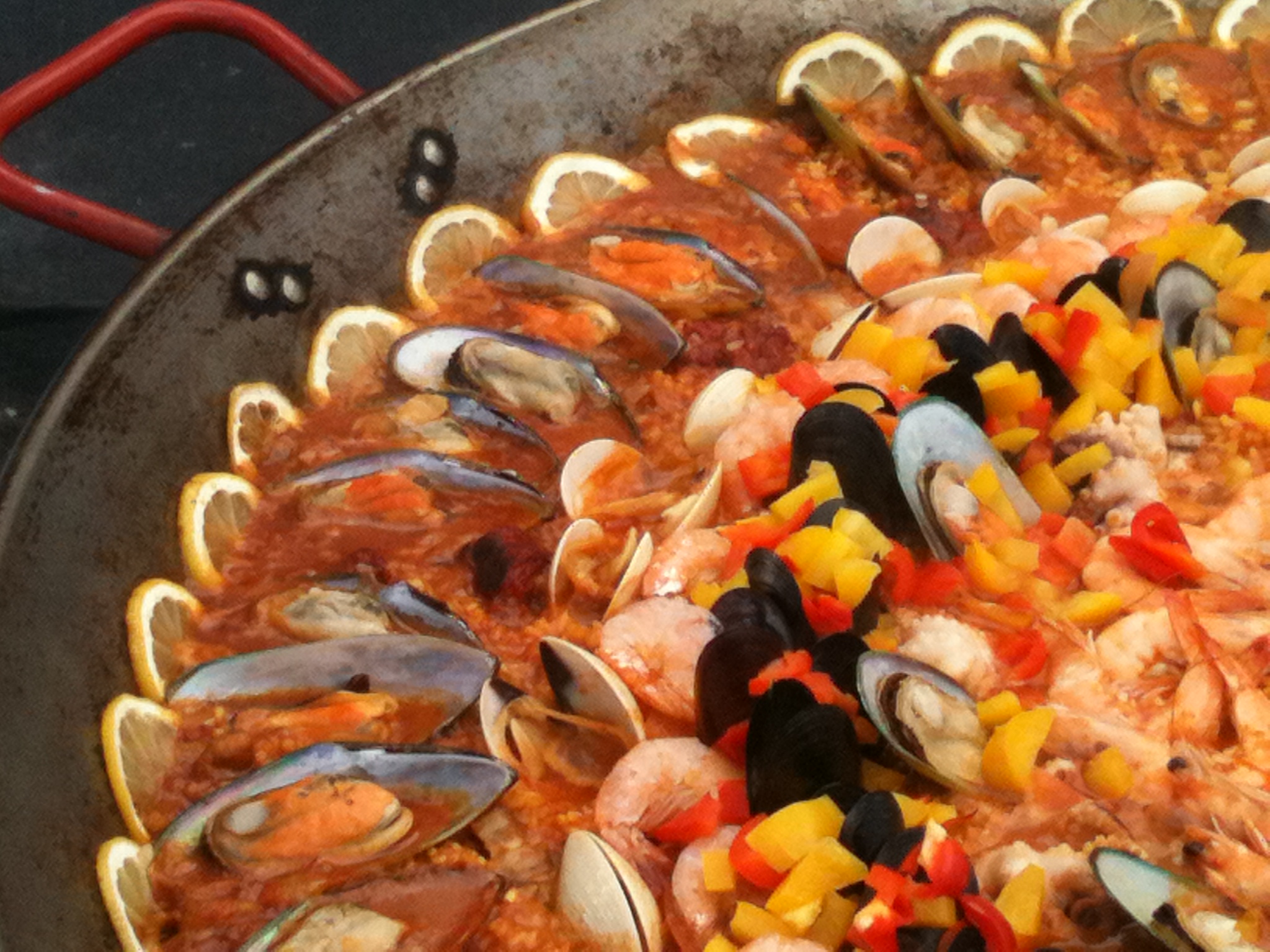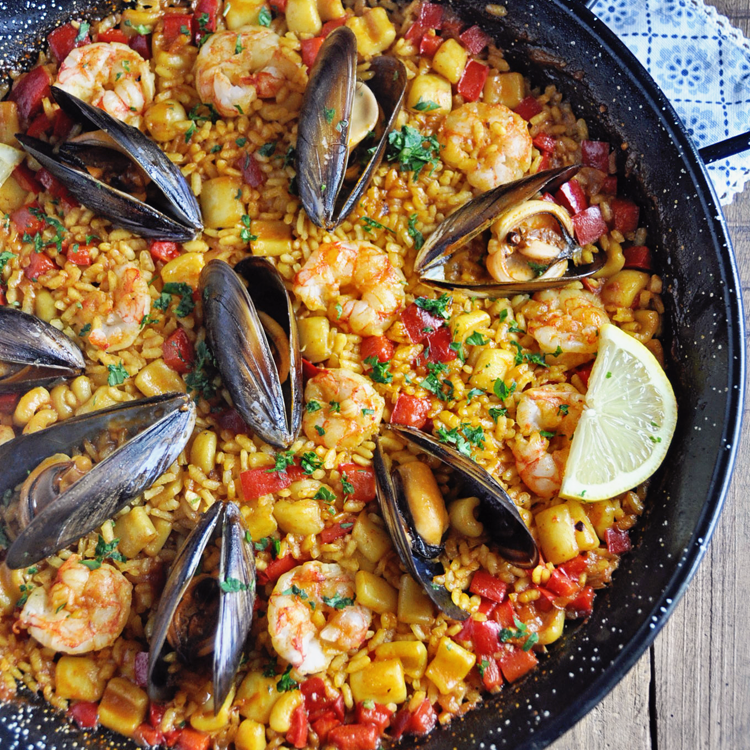Embark on a culinary adventure as we delve into the art of crafting an authentic seafood paella. This beloved Spanish dish, bursting with vibrant flavors and textures, is a symphony of fresh seafood, aromatic spices, and perfectly cooked rice. Join us as we explore the secrets of preparing this iconic dish, ensuring that your paella becomes a masterpiece worthy of any celebration.
From selecting the freshest ingredients to mastering the delicate balance of flavors, we’ll guide you through each step of the process. Whether you’re a seasoned chef or a home cook eager to impress, this comprehensive guide will empower you to create an authentic seafood paella that will tantalize your taste buds and transport you to the vibrant streets of Spain.
Ingredients and their Proportions
Authentic paella is a culinary masterpiece that requires fresh, high-quality ingredients to achieve its signature flavors. Using frozen or pre-packaged seafood will compromise the dish’s integrity.
The following is a detailed list of ingredients with specific measurements for an authentic paella:
Seafood
- 1 pound (450g) mussels, scrubbed and debearded
- 1 pound (450g) clams, scrubbed and soaked in cold water
- 1 pound (450g) shrimp, peeled and deveined
- 1 pound (450g) calamari, cleaned and cut into rings
Rice and Vegetables
- 2 cups (480g) Bomba or Valencia paella rice
- 1 large onion, finely chopped
- 2 red bell peppers, finely chopped
- 2 green bell peppers, finely chopped
- 4 cloves garlic, minced
Stock and Seasonings
- 4 cups (960ml) fish stock or clam juice
- 1/2 cup (120ml) white wine
- 1 tablespoon paprika
- 1/2 teaspoon saffron threads, soaked in 2 tablespoons of warm water
- Salt and black pepper to taste
Saffron
Saffron is a crucial ingredient in paella, imparting its distinctive golden hue and earthy aroma. The threads should be soaked in warm water to release their full flavor and color.
Preparing the Seafood

Cleaning and preparing the seafood is crucial for the success of your paella. Fresh, properly cleaned seafood will impart the best flavor and texture to the dish.
Mussels and Clams
Scrub mussels and clams thoroughly under running water to remove any dirt or debris. Remove any broken or open shells. Discard any mussels or clams that do not close when tapped.
Shrimp
Remove the heads and shells from the shrimp. Use a sharp knife to make a shallow cut along the back of the shrimp and remove the dark vein. Rinse the shrimp under cold water to remove any remaining shell fragments.
Fish
If using whole fish, scale and gut it. Remove the head, tail, and fins. Cut the fish into bite-sized pieces.
Tips for Preserving Freshness and Flavor
* Store the seafood in the refrigerator until ready to use.
- If storing the seafood for more than a few hours, place it on a bed of ice.
- Do not overcook the seafood. Overcooked seafood will become tough and rubbery.
- Add the seafood to the paella towards the end of the cooking process to prevent overcooking.
Cooking the Paella
The traditional method of cooking paella involves using a large, shallow pan called a paella pan. This pan allows for even cooking and helps to create the characteristic crispy bottom of the dish.
To begin, heat some olive oil in the paella pan over medium heat. Once the oil is hot, add the chopped vegetables and sauté until they are softened. Next, add the seafood and cook until it is just cooked through.
Finally, add the rice and cook it until it is tender and flavorful.
Sautéing the Vegetables and Seafood
Sautéing the vegetables and seafood is an important step in cooking paella. It helps to develop the flavors of the dish and create a flavorful base for the rice.
- When sautéing the vegetables, be sure to cook them until they are softened but not browned.
- When sautéing the seafood, be careful not to overcook it. Seafood should be cooked just until it is opaque and firm.
Adding the Rice
Once the vegetables and seafood are cooked, it is time to add the rice. Be sure to use a short-grain rice, such as bomba rice, which is specifically designed for paella.
- When adding the rice, be sure to spread it out evenly in the pan.
- Cook the rice for about 15 minutes, or until it is tender and flavorful.
Creating the Bomba

The bomba is the prized crispy layer that forms at the bottom of the paella pan. It’s a combination of toasted rice and seafood juices that creates an irresistible crunch and flavor contrast to the tender rice above. Achieving the perfect bomba requires a delicate balance of heat and cooking time.
Once the rice has absorbed most of the liquid, it’s time to create the bomba. Increase the heat to medium-high and cook the paella for an additional 5-7 minutes, or until the bottom of the rice starts to sizzle and brown.
Keep a close eye on the paella during this stage, as it can burn easily.
Importance of Heat and Cooking Time
The key to a successful bomba is to use the right amount of heat and cooking time. If the heat is too low, the rice won’t crisp up properly. If the heat is too high, the rice will burn before it has a chance to develop a crispy layer.
The cooking time is also crucial. If the rice is cooked for too long, it will become mushy. If it’s cooked for too short a time, it will be undercooked and hard.
Garnishing and Serving
The final touches to your paella are just as important as the cooking process itself. Traditional garnishes elevate the dish’s flavors and create a visually appealing presentation.
Seafood and Vegetable Arrangement
Arrange the seafood and vegetables aesthetically on top of the paella. Consider using larger pieces of seafood, such as shrimp or mussels, as focal points. Scatter smaller items like peas or bell peppers evenly throughout the dish.
Lemon Wedges
Lemon wedges are a classic garnish for paella. They add a bright, citrusy flavor that complements the seafood. Arrange the wedges around the edge of the paella, allowing diners to squeeze them over their portions.
Parsley
Fresh parsley adds a vibrant green color and a herbaceous aroma to the paella. Sprinkle chopped parsley over the top of the dish, just before serving.
Paprika
A sprinkle of paprika adds a vibrant red color and a slightly smoky flavor to the paella. Use sweet or smoked paprika, depending on your preference.
Serving Temperature
Paella is best served immediately after cooking. This ensures that the rice is still moist and flavorful, and the seafood is cooked to perfection.
Last Point
As you savor the last morsel of your delectable seafood paella, take pride in the culinary journey you’ve undertaken. This dish, steeped in tradition and brimming with authentic flavors, is a testament to your culinary prowess. Remember, the true essence of paella lies in the love and care you pour into its preparation.
So, gather your loved ones, share this culinary masterpiece, and create memories that will last a lifetime.
Q&A
Can I use frozen seafood for my paella?
While fresh seafood is always preferred, frozen seafood can be used in a pinch. However, it’s crucial to thaw the seafood completely and pat it dry before adding it to the paella to avoid diluting the flavors.
What type of rice is best for paella?
Traditionally, paella is made with bomba rice, a short-grain variety known for its ability to absorb and retain flavors without becoming mushy. If bomba rice is unavailable, you can substitute it with Valencia rice or Carnaroli rice.
How do I achieve the perfect crispy layer (socarrat) at the bottom of my paella?
To create the coveted crispy layer, ensure that your paella pan is evenly heated over high heat. Once the rice has cooked for about 15 minutes, reduce the heat to low and continue cooking for an additional 5-7 minutes, or until the bottom of the paella is golden brown and slightly crispy.
